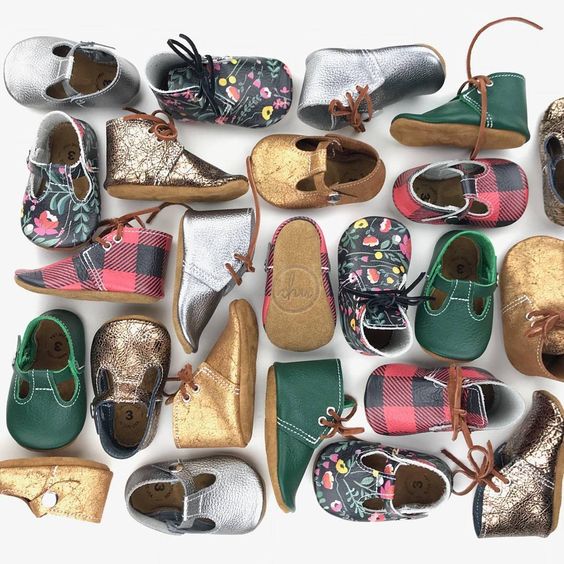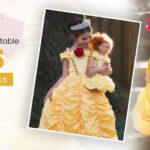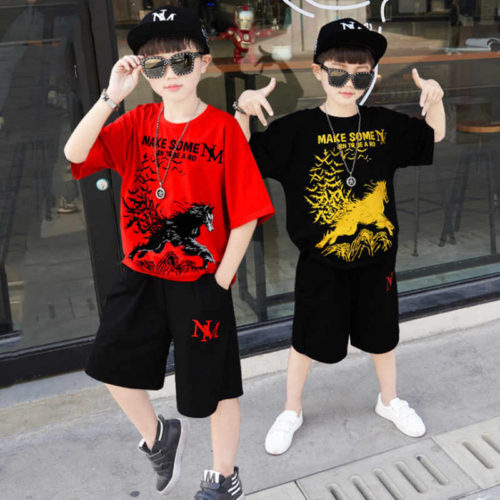Babies typically wear shoe sizes ranging from 0 to 5. Size can vary based on age, growth spurts, and individual foot shape.
Choosing the right shoe size for babies is crucial for their comfort and development. Baby shoe sizes often correspond to their age, but each child grows at their own pace. Newborns usually start at size 0, while toddlers may wear sizes 4 to 5.
Proper fitting shoes support healthy foot growth and ensure stability as they begin to walk. Parents should measure their baby’s feet regularly, as growth can happen quickly. Investing in well-fitted shoes not only enhances mobility but also promotes overall foot health. Understanding baby shoe sizes helps parents make informed decisions for their little ones.
Table of Contents
The Journey Of Baby’s Foot Growth
Understanding your baby’s foot growth is crucial. Their tiny feet change rapidly. Knowing what size shoes do babies wear and what size shoes to buy helps ensure comfort and support.
Initial Development
Babies are born with soft and flexible feet. Their feet are usually around 3 to 4 inches long. This initial stage is vital for their growth.
- Feet are mostly cartilage.
- Bone structure develops over time.
- Foot shape will change as they grow.
Parents should check their baby’s foot size regularly. Using a soft tape measure is easy. Measure from the heel to the tip of the longest toe.
Stages Of Growth
Babies go through several stages of foot growth. Each stage requires different shoe sizes.
| Age Range | Average Shoe Size |
|---|---|
| 0-6 months | Size 0-2 |
| 6-12 months | Size 2-4 |
| 1-2 years | Size 4-6 |
| 2-3 years | Size 6-8 |
Check your baby’s shoes often. Look for signs of tightness or discomfort. Always choose flexible materials for their shoes.
- Allow natural foot movement.
- Choose breathable fabrics.
- Ensure proper fit with room to grow.
Importance Of Proper Shoe Sizing For Babies
Choosing the right shoe size for babies is crucial. Properly fitting shoes support healthy foot development. They also ensure comfort and safety during early walking stages.
Comfort And Safety
Comfort is essential for babies. Uncomfortable shoes can cause blisters and irritation. Here are key points about comfort and safety:
- Soft materials reduce friction and prevent chafing.
- Breathable fabrics keep little feet cool and dry.
- Flexible soles allow natural foot movement.
- Secure fit prevents slipping and falling.
Proper shoe sizing protects babies from injuries. Shoes that are too tight can restrict growth. Shoes that are too loose can lead to tripping.
Impact On Walking Skills
Properly sized shoes play a significant role in walking. They help babies develop balance and coordination. Here’s how shoe size impacts walking skills:
- Encourages natural movement of the foot.
- Provides stability during first steps.
- Supports posture while walking.
- Aids in confidence when exploring new environments.
Choosing the right size promotes overall foot health. It sets a strong foundation for future mobility.
| Age Range | Typical Shoe Size |
|---|---|
| 0-6 months | Size 0-2 |
| 6-12 months | Size 2-4 |
| 12-18 months | Size 4-6 |
| 18-24 months | Size 6-8 |
Decoding Baby Shoe Sizes
Understanding baby shoe sizes is crucial for your child’s comfort. Proper fit supports healthy foot development. Shoes that are too tight or too loose can cause discomfort.
Age As A Sizing Guide
Baby shoe sizes often relate to age. However, age alone isn’t always reliable. Each baby grows at their own pace. Here’s a simple guide:
| Age Range | Approximate Shoe Size |
|---|---|
| 0-3 months | Size 0 |
| 3-6 months | Size 1 |
| 6-12 months | Size 2 |
| 12-18 months | Size 3 |
| 18-24 months | Size 4 |
Remember, this is a general guideline. Always measure your baby’s feet.
Length And Width Considerations
Baby feet come in different shapes. Length and width matter in finding the right shoe size.
Follow these tips for accurate measurements:
- Place your baby’s foot on a piece of paper.
- Trace around the foot with a pencil.
- Measure the longest part of the drawing.
Width is just as important. Some brands offer wide options. Check the shoe size chart before buying. Here’s a quick reference:
| Shoe Size | Width Options |
|---|---|
| Size 1 | Narrow, Standard |
| Size 2 | Standard, Wide |
| Size 3 | Standard, Wide |
Choose the right width for comfort. A well-fitting shoe supports walking and play.
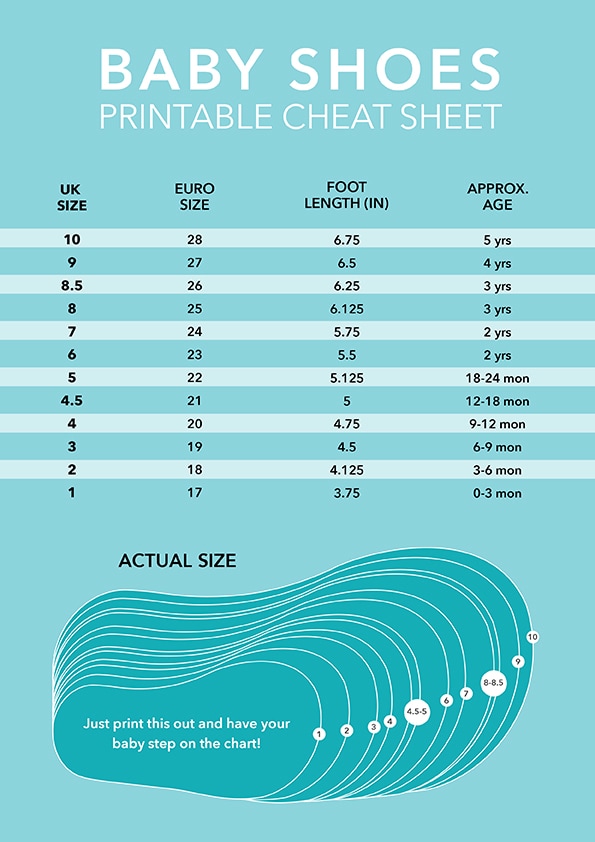
Credit: www.care.com
Related: What Size Do Newborns Wear in Shoes? Find Out Now!
Measuring Your Baby’s Feet Accurately
Finding the right shoe size for your baby is crucial. Accurate measurements ensure comfort and proper foot development. Let’s explore how to measure your baby’s feet correctly.
Tools For Measuring
- Measuring Tape: A flexible tape works best.
- Ruler: Use a ruler for precise measurements.
- Foot Measurement Chart: Print one for easy reference.
- Paper and Pen: To sketch your baby’s foot outline.
Best Practices
- Measure at the End of the Day: Feet swell during the day.
- Stand Up: Have your baby stand while measuring.
- Measure Both Feet: One foot may be larger than the other.
- Add Extra Space: Include about 0.5 inches for growth.
| Foot Size (US) | Foot Length (inches) | Foot Length (cm) |
|---|---|---|
| 0 | 3.5 | 8.9 |
| 1 | 4.0 | 10.2 |
| 2 | 4.5 | 11.4 |
| 3 | 5.0 | 12.7 |
When To Start Putting Shoes On Your Baby
Choosing the right time to put shoes on your baby is important. Babies have unique needs as they grow and develop. Understanding when to transition to shoes helps promote healthy foot development.
Barefoot Benefits
Letting your baby go barefoot has many advantages:
- Natural Development: Barefoot allows feet to grow naturally.
- Strengthening Muscles: It helps strengthen foot muscles.
- Improved Balance: Barefoot walking enhances balance and coordination.
- Better Sensory Feedback: Feet can feel textures and surfaces.
Experts recommend allowing babies to go barefoot indoors. This promotes healthy foot growth and helps develop motor skills. Soft surfaces are ideal for your baby to explore without shoes.
The Right Time For Shoes
Knowing when to put shoes on your baby is crucial. Here are some guidelines:
- Age: Most babies start walking between 9 to 15 months.
- Walking Style: Watch for confident walking. If your baby walks steadily, shoes are appropriate.
- Environment: Shoes are necessary outdoors. Protect delicate feet from hot or rough surfaces.
Choose shoes that fit well. Look for lightweight and flexible materials. Shoes should support, but not restrict, foot movement. Measure your baby’s feet regularly as they grow. This ensures a proper fit and comfort.
| Age Range | Activity | Shoe Recommendation |
|---|---|---|
| 0 – 9 Months | Crawling | Barefoot or soft booties |
| 9 – 15 Months | First Steps | Flexible shoes |
| 15+ Months | Walking | Supportive shoes |
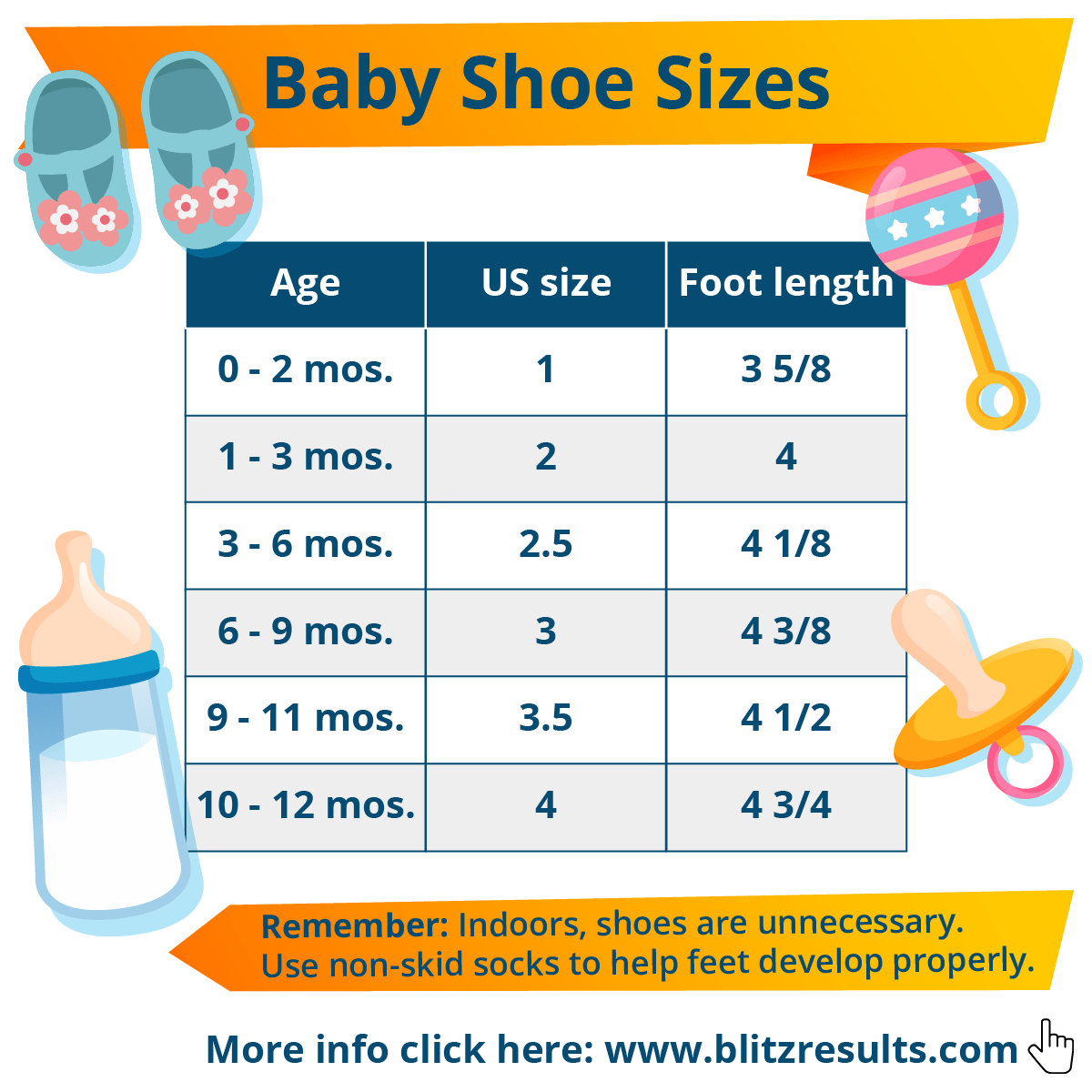
Credit: www.takeoff.sk
Interpreting Shoe Size Charts
Understanding baby shoe sizes can be tricky. Shoe size charts help parents find the right fit for their little ones. Knowing how to read these charts ensures comfort and support for tiny feet.
Reading Size Charts
Size charts provide information on various shoe sizes. They include measurements for different age groups. Here’s a simple guide to help you:
| Age (Months) | US Size | Foot Length (inches) | Foot Length (cm) |
|---|---|---|---|
| 0-3 | 0-1 | 3.5 | 8.9 |
| 3-6 | 2 | 4.0 | 10.2 |
| 6-12 | 3 | 4.5 | 11.4 |
| 12-18 | 4 | 5.0 | 12.7 |
Measure your baby’s foot length. Match it with the chart. This helps ensure a proper fit. Always check the size before buying shoes.
International Size Conversions
Shoe sizes vary across countries. Here’s a quick reference for international conversions:
- US Sizes: Commonly used in the United States.
- UK Sizes: Used in the United Kingdom.
- EU Sizes: Common in European countries.
| US Size | UK Size | EU Size |
|---|---|---|
| 1 | 0 | 16 |
| 2 | 1 | 17 |
| 3 | 2 | 18 |
| 4 | 3 | 19 |
Use this table to convert sizes easily. This helps you find the best fit worldwide. Always check local charts for accuracy.
Related: How to Choose Stylish Shoes for Girls: Top Picks & Tips
Shoe Types And Their Sizing Nuances
Choosing the right shoes for babies is essential. Different types of shoes have unique sizing standards. Understanding these differences helps parents make informed choices.
Sneakers Vs. Soft Soles
Babies can wear two main types of shoes: sneakers and soft soles. Each type serves different purposes and fits differently.
- Sneakers:
- Provide support for active babies.
- Usually made of sturdy materials.
- Fit snugly to prevent slipping.
- Soft Soles:
- Ideal for newborns and early walkers.
- Flexible and lightweight for comfort.
- Allow natural movement of the foot.
Here is a quick sizing comparison:
| Type | Typical Sizes | Best Age Range |
|---|---|---|
| Sneakers | Size 1 to 5 | 12 months to 4 years |
| Soft Soles | Size 0 to 4 | Newborn to 18 months |
Seasonal Footwear Differences
Seasonal changes affect baby shoe choices. Footwear must match the weather conditions.
- Summer:
- Lightweight sandals are popular.
- Breathable materials keep feet cool.
- Winter:
- Insulated boots provide warmth.
- Waterproof options help keep feet dry.
Each season brings unique sizing challenges. Always measure your baby’s feet before purchasing new shoes. This ensures a proper fit for comfort and safety.
Tips For Trying On Baby Shoes
Finding the right size shoes for babies is crucial. Proper fit supports their foot development. Here are some effective tips to try on baby shoes.
Checking For Fit
Ensure the shoes fit snugly but not too tight. Follow these steps for a good fit:
- Measure baby’s foot length.
- Choose a shoe size larger than the foot measurement.
- Check for a thumb’s width of space at the toe.
- Ensure the heel fits snugly without slipping.
Here’s a quick size guide:
| Age | Foot Length (inches) | Approx. Shoe Size |
|---|---|---|
| 0-6 months | 3.5″ | Size 1 |
| 6-12 months | 4.0″ | Size 2 |
| 12-18 months | 4.5″ | Size 3 |
| 18-24 months | 5.0″ | Size 4 |
Observing Baby’s Reaction
Watch how your baby reacts to new shoes. Their comfort is important. Look for these signs:
- Smiles or giggles indicate comfort.
- Frowning or fussiness shows discomfort.
- Baby should walk easily without stumbling.
Let your baby explore the shoes. Encourage them to walk around. This helps ensure a good fit.
Frequency Of Sizing Up
Babies grow quickly. Their shoe size changes often. Parents need to check sizes regularly. Knowing when to size up is crucial for comfort.
Growth Spurts
Babies experience rapid growth spurts. These usually happen:
- Between 0-3 months
- At 6 months
- At 12 months
- At 18 months
During these times, feet may grow up to a full size. Check shoes every month during these periods. This helps ensure a proper fit.
Signs To Size Up
Watch for these signs that indicate it’s time to size up:
- Red Marks: Look for red marks on the feet.
- Difficulty Putting On: Shoes should fit easily.
- Worn Out Soles: Check for signs of wear.
- Cramped Toes: Toes should not be squished.
Regular checks help keep your baby’s feet healthy. Happy feet lead to happy babies!
Common Mistakes In Baby Shoe Sizing
Choosing the right size for baby shoes is crucial. Many parents make mistakes that can affect their child’s comfort and foot development. Understanding these common errors helps ensure a proper fit.
Oversizing
Many parents select shoes that are too big. Oversized shoes may seem convenient. However, they can lead to:
- Slipping off easily
- Increased risk of tripping
- Improper foot development
Babies need shoes that fit snugly. Measure your baby’s feet regularly. Use a soft measuring tape for accuracy. Follow these steps:
- Place your baby’s foot on a flat surface.
- Measure from the heel to the longest toe.
- Check the shoe size chart for the correct fit.
Ignoring Shoe Width
Width is just as important as length. Many parents overlook shoe width. Shoes that are too narrow can cause:
- Discomfort
- Blisters
- Foot deformities
Choose shoes that allow for wiggle room. Here’s how to check width:
| Foot Width | Recommended Width Size |
|---|---|
| 2.5 inches | Standard |
| 3 inches | Wide |
| 3.5 inches | Extra Wide |
Always check the width label on shoes. A proper fit supports healthy growth.
Caring For Baby’s Shoes
Caring for baby shoes is essential for their longevity. Proper cleaning and storage keep them looking new. Babies are active, so their shoes can get dirty quickly. Here are some tips to maintain those little shoes.
Cleaning Tips
Cleaning baby shoes is simple. Follow these steps for best results:
- Remove dirt: Use a soft brush or cloth.
- Spot clean: Use mild soap and water.
- Air dry: Avoid direct sunlight or heat sources.
- Check for damage: Repair any scuffs or tears.
For specific materials:
| Material | Cleaning Method |
|---|---|
| Canvas | Machine wash on a gentle cycle. |
| Leather | Wipe with a damp cloth; apply leather conditioner. |
| Rubber | Rinse with water; scrub with a brush. |
Storage Solutions
Proper storage helps maintain baby shoes. Here are some effective solutions:
- Use a shoe organizer: Keep shoes in one place.
- Keep them dry: Store in a cool, dry area.
- Use shoe boxes: Label boxes for easy access.
- Rotate shoes: Use different pairs to avoid wear.
Consider these tips for seasonal storage:
- Store out-of-season shoes in a separate area.
- Use cedar shoe inserts to prevent odors.
Adapting To Different Walking Surfaces
Babies explore their world by walking on various surfaces. Each surface impacts their shoe needs. Choosing the right shoes helps keep little feet safe and comfortable.
Indoors Vs. Outdoors
Indoor surfaces differ from outdoor ones. Here’s a quick comparison:
| Surface Type | Recommended Shoe Type |
|---|---|
| Indoors | Soft-soled shoes or socks |
| Outdoors | Sturdy shoes with grip |
Indoor environments often have smooth floors. Soft-soled shoes or socks provide comfort and flexibility. They allow babies to feel the ground. This helps them improve balance.
Outdoor surfaces can be rough. Harder soles with good traction are essential. Look for shoes with:
- Non-slip soles
- Breathable materials
- Supportive structures
These features help protect tiny feet from stones or uneven ground.
Special Occasions
Special events require different footwear. Choose shoes that match the occasion while ensuring comfort.
- Weddings: Dress shoes should be well-fitted and comfortable.
- Parties: Fun, colorful shoes can brighten outfits.
- Family Gatherings: Opt for versatile shoes that allow movement.
Remember to check the fit regularly. Babies grow fast, and shoes may need replacing often. Prioritize comfort and safety for every occasion.
Navigating Seasonal Changes In Footwear
Choosing the right shoes for babies varies with the seasons. Each season presents unique challenges and needs. Understanding these changes helps ensure your baby’s comfort and safety.
Summer Shoes
Summer brings warmth and fun. Babies need breathable footwear to keep their feet cool.
- Look for open-toed sandals.
- Choose soft, flexible materials.
- Ensure easy on and off options.
Here are some popular summer shoe types:
| Type of Shoe | Features |
|---|---|
| Sandals | Breathable, easy to wear, and stylish. |
| Water Shoes | Perfect for beach outings and pool days. |
| Slip-ons | Convenient for quick trips outside. |
Winter Boots
Winter requires warm and sturdy footwear. Babies need protection from cold and wet conditions.
- Choose insulated materials.
- Look for waterproof options.
- Ensure a good grip on soles.
Popular winter boot features include:
- Warm lining for extra comfort.
- Adjustable closures for a snug fit.
- Non-slip soles for safety on icy surfaces.
Here are a few recommended winter boots:
| Boot Type | Benefits |
|---|---|
| Snow Boots | Keep feet dry and warm in snow. |
| Insulated Boots | Provide warmth and comfort in cold weather. |
| Rain Boots | Protect against wet weather. |
When To Consult A Professional
Choosing the right shoe size for your baby is important. Sometimes, a professional can help. Knowing when to seek advice can save you time and worry.
Foot Development Concerns
Watch for signs of foot problems as your baby grows. Here are some common concerns:
- Pain or discomfort: Your baby may cry or fuss.
- Flat feet: Look for a lack of arches.
- Unusual walking patterns: Check for wobbling or limping.
- Redness or swelling: Check for irritation around the feet.
These signs may mean it’s time to consult a professional. Early intervention helps your child’s foot health.
Professional Fittings
Consider getting a professional fitting for your baby’s shoes. Benefits include:
- Correct size measurement
- Advice on shoe types
- Understanding foot development stages
Visit a trusted store or a pediatric specialist. They can ensure your child wears the right size shoes.
Many stores offer free fittings. Always ask for help if unsure about shoe choices.
Online Shopping For Baby Shoes
Shopping for baby shoes online offers convenience and variety. Parents can explore countless styles and sizes from home. Understanding how to navigate this process makes it easier.
Virtual Sizing Tools
Many online stores provide virtual sizing tools. These tools help parents find the perfect fit for their babies. Here’s how they work:
- Foot Measurement Guides: Most sites offer printable guides. Measure your baby’s foot at home.
- Size Charts: Compare your measurement with the size chart. Each brand may have different sizing.
- Try-On Videos: Some retailers show videos on how shoes should fit. This helps visualize the size better.
Using these tools can reduce returns and ensure a snug fit.
Return Policies
Before buying, check the return policies. Babies grow fast, and shoes may not fit long. Here are key points to consider:
- Return Window: Look for a 30-day return window. This gives time for fitting.
- Free Returns: Some stores offer free return shipping. This saves money.
- Exchanges: Check if exchanges for a different size are easy. This helps find the right fit without extra hassle.
Understanding return policies makes online shopping stress-free.
Related: How to Find Fashionable Baby Shoes: Ultimate Guide

Credit: carriageboutique.com
Frequently Asked Questions
What Size Shoes Do Newborns Wear?
Newborns typically wear shoe sizes ranging from 0 to 1, depending on their foot length.
How Do I Measure My Baby’s Foot Size?
Use a ruler or a measuring tape to measure the foot from heel to toe for accurate sizing.
At What Age Do Babies Need Shoes?
Babies usually need shoes around 9 to 12 months when they start walking.
Should Babies Wear Shoes Indoors?
It’s best for babies to go barefoot indoors to develop their foot strength and balance.
How Often Should I Check My Baby’s Shoe Size?
Check your baby’s shoe size every 2-3 months, as their feet grow rapidly during the first few years.
Conclusion
Choosing the right shoe size for your baby is essential for their comfort and development. Regularly measure their feet to ensure a proper fit. Remember, each brand may vary in size. Prioritize quality and support as your little one grows.
Happy shoe shopping for your tiny toes!



